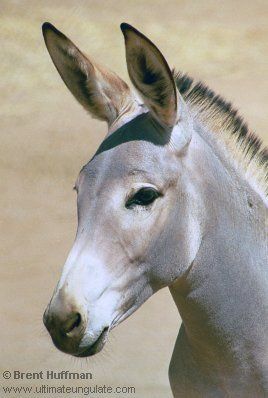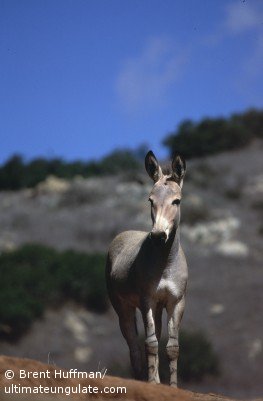 The African wild ass (Equus africanus) can cope with a high dehydration level of 30%, and like other desert-dwellers once it gets access to water it can restore fluid loss in a very short time. The species was domesticated about 6,000 years ago and these donkeys are now extremely common, yet only a few of their wild ancestors survive.
The African wild ass (Equus africanus) can cope with a high dehydration level of 30%, and like other desert-dwellers once it gets access to water it can restore fluid loss in a very short time. The species was domesticated about 6,000 years ago and these donkeys are now extremely common, yet only a few of their wild ancestors survive.
Horses are perissodactyls (odd-toed ungulates), a group that also includes rhinoceroses and tapirs. The first horses appeared around 56 million years ago, the diversity of which peaked and then dramatically decreased around 12,000 years ago. All went extinct except the Equus (modern horse) genus and today wild horses are found only in parts of Africa and Asia.
The African wild ass is the ancestor of all domestic donkeys. Its smooth coat varies in colour and most individuals have a dark stripe along the spine.
It has long and narrow hooves designed for stability rather than speed, and its weight varies around 250kg. The species is a grazer, eating mostly grasses and also herbs.

The wild ass used to occur all over northern Africa, possibly even up to the Arabian Peninsular, but now only small scattered populations exist in northeast Ethiopia, Eritrea and Somalia.
Unfortunately, it is Critically Endangered because fewer than 570 individuals are thought to survive: about 400 in Eritrea, less than 160 in Ethiopia, and a maximum of 10 in Somalia.
The African wild ass is decreasing in all areas of its range with the exception of Eritrea, which is the only remaining stable population.
The species is hunted for bushmeat and its body parts are used in traditional African medicine, which is probably a main cause of decline in Ethiopia and Somalia.
The wild ass often has to compete for food with livestock, and is blocked from water sources in some places because of agriculture.
It is protected by law in Sudan, Somalia and Ethiopia, although these laws are difficult to enforce, and individuals that exist in reserves still have to share the land with many farmers and livestock.
Links
- Basel Zoo (Wild ass captive breeding programme)
